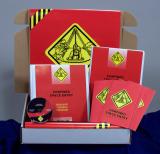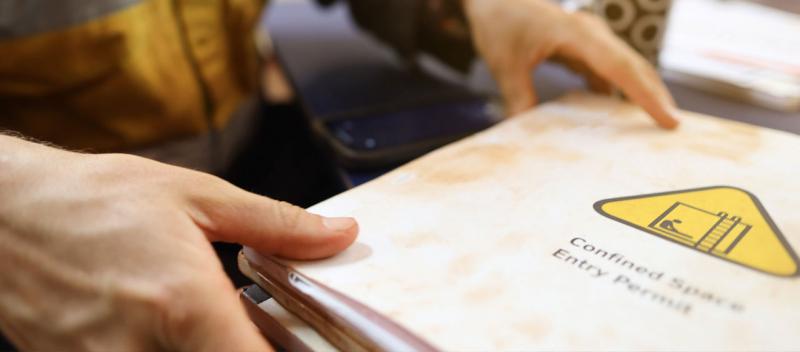Confined Space Awareness Safety Tips
Not all of us work in cubicles or corner offices with a view. There are many people who work in areas considered "confined spaces". This is a term for places not exactly designed for human beings, but just big enough for someone to enter and conduct one kind of task or another.
Confined spaces include, but are not limited to, tanks, vessels, silos, storage bins, hoppers, vaults, pits, manholes, tunnels, equipment housings, ductwork, pipelines, etc. Continuous occupation is not something that's recommended, as these are spaces which limit mobility, exit, and room to operate. That's to say nothing of claustrophobia (if you have this condition and work in confined spaces, it could be time to reconsider your career choice).
In addition, confined spaces can present atmospheric hazards. With limited amounts of space, there's not much room for airflow to clear out an airborne toxic which could be poisonous or harmful. Luckily, this kind of hazard -- any sort of hazard related to a confined space -- can be prevented if addressed prior to entering the space.
THE RABBIT HOLE
Contrary to a rabbit hole, most confined spaces that workers function in have an end-point with very limited capability for movement or course-change options. They are also riddled with danger. Confined space workers don’t have the kind of luxuries rabbits do.
In 2004, the Occupational Safety and Health Administration (OSHA) received notification of a construction site incident, after an employee was found at the bottom of a manhole, unconscious. Carbon dioxide was the cause and 5 similar cases had already occurred since 2000 with 4 of them as fatalities. OSHA has provided many standards that are now set in place for the protection of employees who enter and work in confined spaces. These regulations, by protecting workers, also protect the companies they work for, which most people don't realize. By ensuring the safety of employees, if followed properly, standards in place for confined spaces ensures that organizations won't have to deal with the disaster of an injured worker, or worse.
Confined spaces can have one or more of the following characteristics, classified by OSHA:
- Contains or has the potential to contain a hazardous atmosphere.
- Contains material that has the potential to engulf an entrant.
- Has walls that converge inward or floors that slope downward and taper into a smaller area which could trap or asphyxiate an entrant.
- Contains any other recognized safety or health hazard, such as unguarded machinery, exposed live wires, or heat stress.
These characteristics set in motion an assortment of rules and regulations that govern confined spaces within OSHA jurisdiction. There are regulations for hazardous materials, general environmental controls, procedures for atmospheric testing, sewer system entry requirements, rescue team criteria, and a host of other Code of Federal Regulations (CFRs) that manage how confined spaces should be handled with the worker’s safety in mind. It is the company’s responsibility to point these regulations out to a worker and it is the employee’s responsibility to actually read them.
THE SMALL PICTURE
Most people want to know what the big picture is about a subject. In the case of confined spaces, it’s a dad joke to say it’s more like a “small picture”, but this description is accurate, nonetheless. While there are a plethora of laws designed to ensure the safety of those who work in confined spaces, the small picture is there is definitely a short list of essentials employees should be aware of when working in a confined space (though federal regulations are necessary to understand, as well).
Hazard Free - Before entering a confined space, make sure it has a permit for entry and that the area is void of harmful materials and substances. This includes atmospheric conditions, beforehand. Is there explosive gas present? What about high levels of carbon dioxide? Is there oxygen? These are important items to clarify before even starting the job.
Personal Protective Equipment (PPE) – Use it. It’s there for a reason. At least, it should be there. If it’s not, you have another problem on your hands. Harnesses, lifelines, gas monitoring devices, breathing masks and tanks, burn protection clothing…these are all important items that need to be put into use and made available. Alongside PPE, communications equipment is also vital and should be present.
Teamwork – Take care of one another. Help each other. Look out for the other guy or gal. Hopefully, they are doing the same for you. Working in confined spaces is a risky business, and no single person should be going at it alone. You may be tied to a lifeline, but your best lifeline is your co-worker and teammate. Have the other person’s back at all times, just as they should have yours. Dangerous work requires a higher attention to detail, and must be treated very carefully. We all need help with that level of work.
Working without incident is an important objective, and it should be every company’s goal to achieve what might considered impossible, but worth the effort anyway. When it comes to an employee’s life, nothing less is acceptable.
Join Our Free HR Training Solutions eNewletter
Join our free HR Training Solutions eNewsletter today to stay up-to-date on the latest industry trends, training and development programs, best practices, and expert insights. Gain valuable knowledge, enhance your skills, improve your organization, build productive teams and elevate your career. Don't miss out on this invaluable resource – sign up now for our free HR Training Solutions eNewsletter!

Confined Space Entry Regulatory Compliance Kit
The Confined Space Entry Regulatory Compliance Kit provide employees with the information they need to stay safe in Permit Spaces and helps employers stay in compliance with OSHA requirements… whether they doing "general industry" or "construction" type work.





